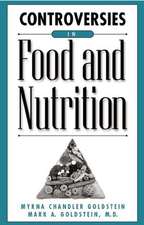Encyclopedia of Junk Food and Fast Food
Autor Andrew F. Smithen Limba Engleză Hardback – 29 aug 2006 – vârsta până la 17 ani
Preț: 401.14 lei
Preț vechi: 693.32 lei
-42% Nou
Puncte Express: 602
Preț estimativ în valută:
76.78€ • 83.43$ • 64.54£
76.78€ • 83.43$ • 64.54£
Carte tipărită la comandă
Livrare economică 21 aprilie-05 mai
Preluare comenzi: 021 569.72.76
Specificații
ISBN-13: 9780313335273
ISBN-10: 0313335273
Pagini: 368
Dimensiuni: 178 x 254 x 29 mm
Greutate: 0.93 kg
Editura: Bloomsbury Publishing
Colecția Greenwood
Locul publicării:New York, United States
ISBN-10: 0313335273
Pagini: 368
Dimensiuni: 178 x 254 x 29 mm
Greutate: 0.93 kg
Editura: Bloomsbury Publishing
Colecția Greenwood
Locul publicării:New York, United States
Notă biografică
Andrew F. Smith is an independent scholar and speaker specializing in education, history, and culinary themes. He is the author of several books on popular foods, such as Popped Culture: A Social History of Popcorn in America (1999), Souper Tomatoes: The Story of America's Favorite Food (2000), and Peanuts: The Illustrious History of the Goober Pea (2002). He was also the editor in chief of The Oxford Encyclopedia of Food and Drink in America (2004).
Cuprins
PrefaceAcknowledgmentsList of EntriesList of Entries by TopicIntroductionChronologyThe EncyclopediaGlossarySelected BibliographyResource GuideIndex
Recenzii
The entries are alphabetically starting with A&W Root Beer (A&W was the first fast food franchise) and ending with Yum! Brands, Inc. (the world's largest fast food company). Most entries are a couple paragraphs in length, and suggested readings follow each one. Boldface terms within an entry have their own entries within the encyclopedia. The volume begins with an alphabetical list of all the entries, followed by a list of entries by topic, and an introduction to the origin of fast food and junk food. A chronology starts with the founding of the Schweppes Company in 1783, and ends with the three major soft drink companies that agreed to a ban on selling sweetened sodas in schools in 2006. Includes a glossary. Highly recommended. All collections; all levels.
In approximately 250 A-to-Z entries, each ranging from several paragraphs to several pages in length, Smith covers specific junk and fast foods (e.g., Snickers, M&Ms) and companies (e.g., Mars, McDonald's) as well as broader topics, such as the environmental and nutritional effects of these industries. Each entry includes at least one suggestion for further reading; a glossary of terms and a chronology of important events are a nice touch. Smaller libraries and libraries on a budget will find that information on some of the subjects here can also be found in other sources, e.g., Smith's Oxford work, but those needing a source focusing solely on the topic of junk food will find this fun and fascinating encyclopedia very useful. For academic and public libraries.
[A] valuable contribution which will be helpful to a wide range of readers and students
Fast food is ready-to-eat foods served promptly after ordering. Alphabetically arranged entries cover the types of junk food (Extruded snacks, Ginger ale, Hot dogs); specific brands (Moon Pie, Mounds Bar, Mountain Dew); companies (Frito-Lay, Kentucky Fried Chicken, Panda Express); health issues (Diabetes, Foodborne illnesses); and a variety of other related topics, from Animal rights movement, Anti-unionization, and Architecture and design to Sports sponsorships, Vending machines, and Waste. In addition to an alphabetical list of entries, there is a list of entries by topic (for example, Bakery Goods, Beverages). A chronology highlights milestones in the fast-food and junk-food industry..The volume concludes with a glossary, selected bibliography, resource guide, and an index. This would be ideal for public libraries as well as undergraduate and high-school libraries.
[T]his volume provides a valuable record of the decline of the American diet over the twentieth century, with the transition from junk food as an occasional treat to junk food as a replacement for real food. There is a fine entry on gross-out candy, a new phenomenon of deliberately revolting confectionary; and a coolly disturbing account of hamburgers..Smith confirms that, with junk food, the joy and the horror are never far apart.
From uniforms and conformity to packaging and pricing, common business practices are explained. Articles on automobiles, drive-ins, films and toys explore the impact of fast food chains on popular culture. Growing health issues are examined in essays on cholesterol, diabetes, nutritional guidelines and obesity. Other concerns include factory farming, globalization and genetically modified foods. Boycotts, lawsuits, protests and politics are just a few of the issues examined. This concise guide is suitable for high school, public and academic libraries.
[A] fascinating examination of food culture in America..Readers will experience a variety of emotions while perusing this book -- nostalgia for the early days of the hamburger and childhood candy favorites as well as abhorrence at the descriptions of factory farming and the negative health effects of a 'super size-me' mentality. The sheer scope of information available here makes this book a must-have resource. The extensive bibliography and suggested readings will be invaluable tools for further research.
In approximately 250 A-to-Z entries, each ranging from several paragraphs to several pages in length, Smith covers specific junk and fast foods (e.g., Snickers, M&Ms) and companies (e.g., Mars, McDonald's) as well as broader topics, such as the environmental and nutritional effects of these industries. Each entry includes at least one suggestion for further reading; a glossary of terms and a chronology of important events are a nice touch. Smaller libraries and libraries on a budget will find that information on some of the subjects here can also be found in other sources, e.g., Smith's Oxford work, but those needing a source focusing solely on the topic of junk food will find this fun and fascinating encyclopedia very useful. For academic and public libraries.
[A] valuable contribution which will be helpful to a wide range of readers and students
Fast food is ready-to-eat foods served promptly after ordering. Alphabetically arranged entries cover the types of junk food (Extruded snacks, Ginger ale, Hot dogs); specific brands (Moon Pie, Mounds Bar, Mountain Dew); companies (Frito-Lay, Kentucky Fried Chicken, Panda Express); health issues (Diabetes, Foodborne illnesses); and a variety of other related topics, from Animal rights movement, Anti-unionization, and Architecture and design to Sports sponsorships, Vending machines, and Waste. In addition to an alphabetical list of entries, there is a list of entries by topic (for example, Bakery Goods, Beverages). A chronology highlights milestones in the fast-food and junk-food industry..The volume concludes with a glossary, selected bibliography, resource guide, and an index. This would be ideal for public libraries as well as undergraduate and high-school libraries.
[T]his volume provides a valuable record of the decline of the American diet over the twentieth century, with the transition from junk food as an occasional treat to junk food as a replacement for real food. There is a fine entry on gross-out candy, a new phenomenon of deliberately revolting confectionary; and a coolly disturbing account of hamburgers..Smith confirms that, with junk food, the joy and the horror are never far apart.
From uniforms and conformity to packaging and pricing, common business practices are explained. Articles on automobiles, drive-ins, films and toys explore the impact of fast food chains on popular culture. Growing health issues are examined in essays on cholesterol, diabetes, nutritional guidelines and obesity. Other concerns include factory farming, globalization and genetically modified foods. Boycotts, lawsuits, protests and politics are just a few of the issues examined. This concise guide is suitable for high school, public and academic libraries.
[A] fascinating examination of food culture in America..Readers will experience a variety of emotions while perusing this book -- nostalgia for the early days of the hamburger and childhood candy favorites as well as abhorrence at the descriptions of factory farming and the negative health effects of a 'super size-me' mentality. The sheer scope of information available here makes this book a must-have resource. The extensive bibliography and suggested readings will be invaluable tools for further research.














